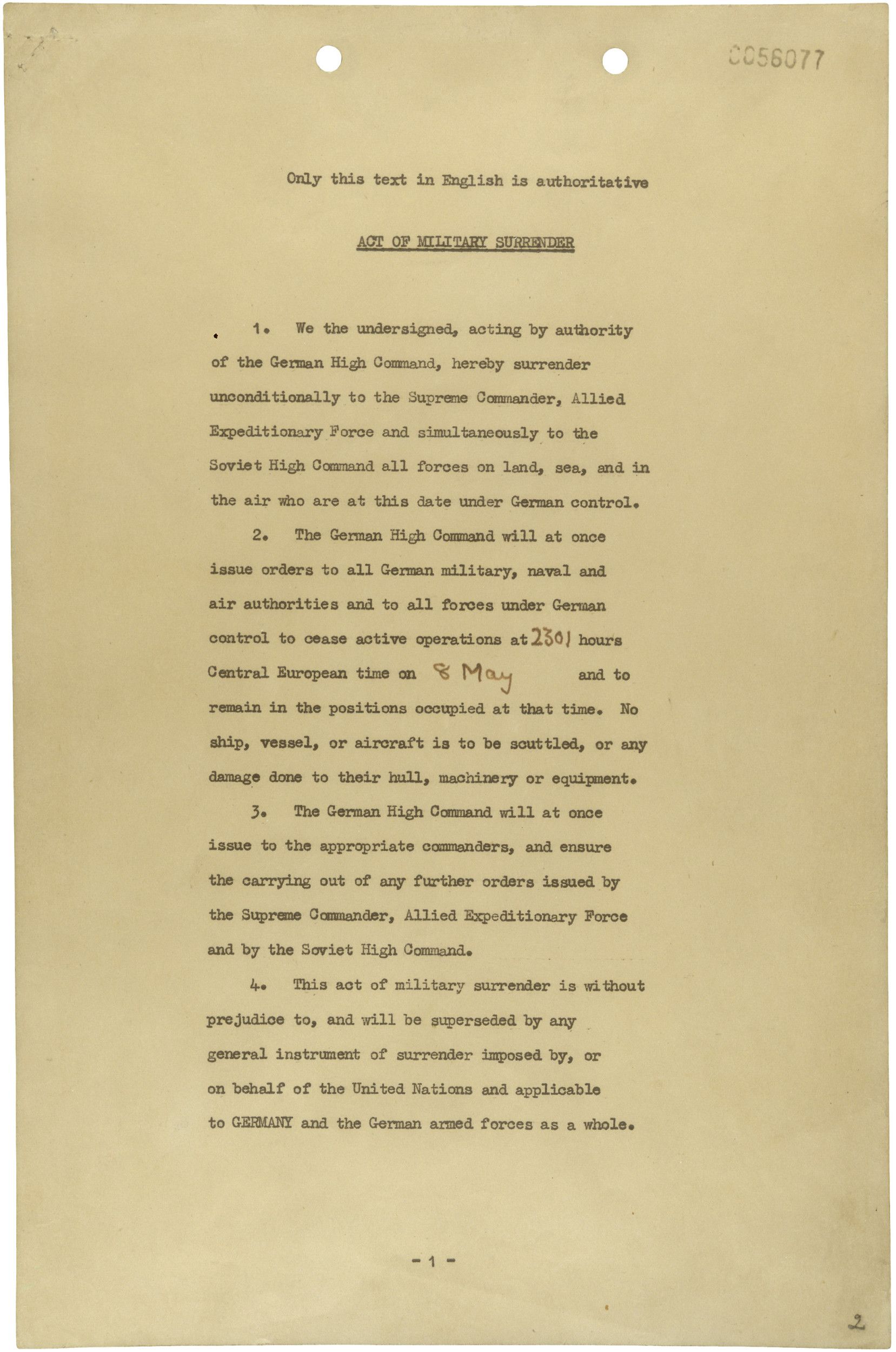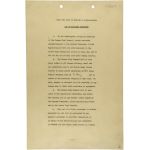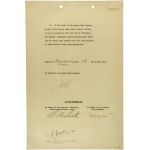Act of Military Surrender by Germany
5/7/1945
Add to Favorites:
Add all page(s) of this document to activity:

Add only page 1 to activity:
Add only page 2 to activity:
This instrument of surrender, the unconditional surrender of the German Third Reich, was signed in the early morning hours of May 7, 1945, at General Dwight D. Eisenhower's headquarters in Reims, in northeastern France. It was signed by General Alfred Jodl, Chief of Staff of the German Army. At the same time, he signed three other surrender documents, one each for Great Britain, Russia, and France.
Present were representatives of the four Allied Powers—France, Great Britain, the Soviet Union, and the United States—and the three Germany officers delegated by German President Karl Doenitz. These were: Gen. Alfred Jodl, who alone had been authorized to sign the surrender document; Maj. Wilhelm Oxenius, an aide to Jodl; and Adm. Hans-Georg von Friedeburg, one of the German chief negotiators.
Lt. Gen. Walter Bedell Smith, chief of staff for the Supreme Headquarters, Allied Expeditionary Force (SHAEF), led the Allied delegation as the representative of General Eisenhower. Eisenhower refused to meet with the Germans until the surrender had been accomplished. Other American officers present were Maj. Gen. Harold R. Bull and Gen. Carl Spaatz.
After the signing of the Reims accord, Soviet chief of staff Gen. Alexei Antonov expressed concern to SHAEF that the continued fighting in the east between Germany and the Soviet Union made the Reims surrender look like a separate peace. The Soviet command wanted the Act of Military Surrender, with certain additions and alterations, to be signed at Berlin. To the Soviets, the documents signed at Berlin on May 8, 1945, represented the official, legal surrender of the Third Reich. The Berlin document had few significant changes from the one signed a day earlier at Reims.
Present were representatives of the four Allied Powers—France, Great Britain, the Soviet Union, and the United States—and the three Germany officers delegated by German President Karl Doenitz. These were: Gen. Alfred Jodl, who alone had been authorized to sign the surrender document; Maj. Wilhelm Oxenius, an aide to Jodl; and Adm. Hans-Georg von Friedeburg, one of the German chief negotiators.
Lt. Gen. Walter Bedell Smith, chief of staff for the Supreme Headquarters, Allied Expeditionary Force (SHAEF), led the Allied delegation as the representative of General Eisenhower. Eisenhower refused to meet with the Germans until the surrender had been accomplished. Other American officers present were Maj. Gen. Harold R. Bull and Gen. Carl Spaatz.
After the signing of the Reims accord, Soviet chief of staff Gen. Alexei Antonov expressed concern to SHAEF that the continued fighting in the east between Germany and the Soviet Union made the Reims surrender look like a separate peace. The Soviet command wanted the Act of Military Surrender, with certain additions and alterations, to be signed at Berlin. To the Soviets, the documents signed at Berlin on May 8, 1945, represented the official, legal surrender of the Third Reich. The Berlin document had few significant changes from the one signed a day earlier at Reims.
Transcript
Only this text in English is authoritativeACT OF MILITARY SURRENDER
1. We the undersigned, acting by authority of the German High Command, hereby surrender unconditionally to the Supreme Commander, Allied Expeditionary Forces and simultaneously to the Soviet High Command all forces on land, sea and in the air who are at this date under German control.
2. The German High Command will at once issue orders to all German military, naval and air authorties and to all forces under German control to cease active operations at 2301 hours Central European time on 8 May and to remain in the positions occupied at that time. No ship, vessel, or aircraft is to be scuttled, or any damage done to their hull, machinery or equipment.
3. The German High Command will at once issue to the appropriate commander, and ensure the carrying out of any further orders issued by the Supreme Commander, Allied Expeditionary Force and by the Soviet High Command.
4. This act of military surrender is without prejudice to, and will be superseded by any general instrument of surrender imposed by, or on behalf of the United Nations and applicable to GERMANY and the German armed forces as a whole.
5. In the event of the German High Command or any of the forces under their control failing to act in accordance with this Act of Surrender, the Supreme Commander, Allied Expeditionary Force and the Soviet High Command will take such punitive or other action as they deem appropriate.
Signed at RHEIMS at 0241 on the 7th day of May, 1945. France
On behalf of the German High Command.
JODL
IN THE PRESENCE OF
On behalf of the Supreme Commander,
Allied Expeditionary Force.
W. B. SMITH
On behalf of the Soviet High Command
SOUSLOPAROV
F SEVEZ
Major General, French Army
(Witness)
This primary source comes from the Records of the U.S. Joint Chiefs of Staff.
National Archives Identifier: 1747981
Full Citation: Act of Military Surrender; 5/7/1945; Instruments of German Surrender, 5/4/1945 - 5/10/1945; Records of the U.S. Joint Chiefs of Staff, Record Group 218; National Archives at College Park, College Park, MD. [Online Version, https://www.docsteach.org/documents/document/act-military-surrender, April 19, 2024]Rights: Public Domain, Free of Known Copyright Restrictions. Learn more on our privacy and legal page.





